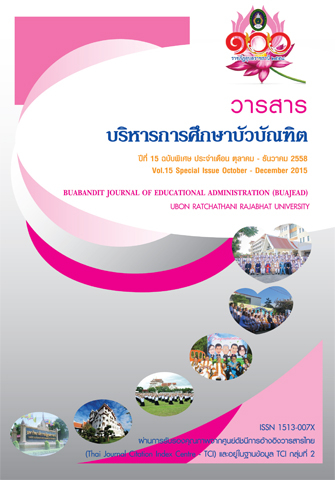การประเมินหลักสูตรพุทธศาสตรบัณฑิต สาขาวิชาสังคมศึกษา มหาวิทยาลัยมหาจุฬาลงกรณราชวิทยาลัย พุทธศักราช 2550
Main Article Content
บทคัดย่อ
การวิจัยครั้งนี้มีวัตถุประสงค์เพื่อประเมินหลักสูตรพุทธศาสตรบัณฑิต สาขาวิชาสังคมศึกษา มหาวิทยาลัยมหาจุฬาลงกรณราชวิทยาลัย พุทธศักราช 2550 การประเมินใช้รูปแบบการประเมินของ สตัฟเฟิลบีม (Stufflebeam) โดยประเมินทั้งระบบของหลักสูตร 4 ด้าน ได้แก่ บริบท ปัจจัยนำเข้า กระบวนการ และผลผลิต ของหลักสูตรพุทธศาสตรบัณฑิต สาขาวิชาสังคมศึกษา ตามทัศนะของผู้เกี่ยวข้อง ผู้วิจัยได้สร้างเครื่องมือเป็น แบบประเมินด้านต่าง ๆ แล้วให้กลุ่มตัวอย่าง 4 กลุ่ม ได้แก่ อาจารย์ จำนวน 30 รูป/คน นิสิตชั้นปีที่ 2-4 จำนวน 176 รูป นิสิตชั้นปีที่ 5 จำนวน 35 รูป ผู้ใช้นิสิตชั้นปีที่ 5 จำนวน 15 รูป/คน เป็นผู้ตอบแบบประเมินในด้านที่เกี่ยวข้อง กับกลุ่มตัวอย่างสถิติที่ใช้ในการวิเคราะห์ข้อมูล ได้แก่ ค่าร้อยละ (Percentage) การหาค่าเฉลี่ย (Mean) ส่วนเบี่ยงเบน มาตรฐาน (Standard Deviation)
ผลการวิจัย พบว่า ด้านบริบท หลักสูตรพุทธศาสตรบัณฑิต สาขาวิชาสังคมศึกษา มหาวิทยาลัย มหาจุฬาลงกรณราชวิทยาลัย พุทธศักราช 2550 ในบริบทด้านปรัชญาและวัตถุประสงค์ของหลักสูตร พบว่า ผู้ประเมินที่เป็นอาจารย์ และนิสิตชั้นปีที่ 5 ให้คะแนนประเมินเฉลี่ยในภาพรวมอยู่ในระดับมาก ส่วนผู้ประเมิน ที่เป็นนิสิตชั้นปีที่ 2-4 ให้คะแนนประเมินเฉลี่ยในภาพรวมอยู่ในระดับปานกลาง บริบทด้านโครงสร้างของหลักสูตร พบว่า ผู้ประเมินที่เป็นอาจารย์ และนิสิตชั้นปีที่ 5 ให้คะแนนประเมินเฉลี่ยในภาพรวมอยู่ในระดับมาก ส่วนผู้ประเมิน ที่เป็นนิสิตชั้นปีที่ 2-4 ให้คะแนนประเมินเฉลี่ยในภาพรวมอยู่ในระดับปานกลาง บริบทด้านเนื้อหาของหลักสูตร พบว่า ผู้ประเมินที่เป็นอาจารย์ และนิสิตชั้นปีที่ 5 ให้คะแนนประเมินเฉลี่ยในภาพรวมอยู่ในระดับมาก ส่วนผู้ประเมิน ที่เป็นนิสิตชั้นปีที่ 2-4 ให้คะแนนประเมินเฉลี่ยในภาพรวมอยู่ในระดับปานกลาง
ด้านปัจจัยเบื้องต้น พบว่า ปัจจัยเบื้องต้นด้านผู้สอน ผู้ประเมินที่เป็นอาจารย์ นิสิตชั้นปีที่ 2-4 และ นิสิตชั้นปีที่ 5 ให้คะแนนประเมินเฉลี่ยในภาพรวมอยู่ในระดับมาก ปัจจัยเบื้องต้นด้านผู้เรียน พบว่า ผู้ประเมิน ที่เป็นอาจารย์ และนิสิตชั้นปีที่ 5 ให้คะแนนประเมินเฉลี่ยในภาพรวมอยู่ในระดับมาก ส่วนผู้ประเมินที่เป็นนิสิต ชั้นปีที่ 2-4 ให้คะแนนประเมินเฉลี่ยในภาพรวมอยู่ในระดับปานกลาง ปัจจัยเบื้องต้นด้านสิ่งอำนวยความสะดวก ในการจัดการเรียนการสอน พบว่า ผู้ประเมินที่เป็นอาจารย์ นิสิตชั้นปีที่ 2-4 และนิสิตชั้นปีที่ 5 ให้คะแนน ประเมินเฉลี่ยในภาพรวมอยู่ในระดับมาก
ด้านกระบวนการ พบว่า การบริหารจัดการหลักสูตร ผู้ประเมินที่เป็นอาจารย์ นิสิตชั้นปีที่ 2-4 และ นิสิตชั้นปีที่ 5 ให้คะแนนประเมินเฉลี่ยในภาพรวมอยู่ในระดับมาก ด้านกระบวนการจัดการเรียนการสอน พบว่า ผู้ประเมินที่เป็นอาจารย์ นิสิตชั้นปีที่ 2-4 และนิสิตชั้นปีที่ 5 ให้คะแนนประเมินเฉลี่ยในภาพรวมอยู่ในระดับมาก ด้านการประเมินผลการเรียน พบว่า ผู้ประเมินที่เป็นอาจารย์ และนิสิตชั้นปีที่ 5 ให้คะแนนประเมินเฉลี่ยในภาพรวม อยู่ในระดับมาก ส่วนผู้ประเมินที่เป็นนิสิตชั้นปีที่ 2-4 ให้คะแนนประเมินเฉลี่ยในภาพรวมอยู่ในระดับปานกลาง
ด้านผลผลิต พบว่า ด้านคุณลักษณะที่พึงประสงค์ ผู้ประเมินที่เป็นอาจารย์ นิสิตชั้นปีที่ 5 และผู้ใช้ นิสิตชั้นปีที่ 5 ให้คะแนนประเมินเฉลี่ยในภาพรวมอยู่ในระดับมาก
An Evaluation of Bachelor of Arts Programmer in Social Studies at Mahachulalongkornrajavidyalaya University in 2007
The objective of this research was to evaluate the Bachelor of Arts Programme in Social Studies at Mahachulalongkornrajavidyalaya University in 2007 by the Stufflebeam’s model. The evaluation of curriculum system consisted of 4 aspects: context, input, process, and output of Bachelor of Arts Programme in Social Studies according to the views of the related people. The tool of the research was the evaluation form. The samples had 4 groups: 30 instructors, 176 second-forth year students, 35 fifth year students, and 15 trainers of the fifth year students. The statistics for dada analysis used Percentage, Mean, Standard Deviation.
The results of the research found that for the context, the Bachelor of Arts Programme in Social Studies at Mahachulalongkornrajavidyalaya University in 2007 for the context on philosophy and objectives of the curriculum found that the evaluators who were the instructors and the fifth year students evaluated the curriculum at the high level. The second-forth year students evaluated the curriculum at the middle level. The context on the structure of the curriculum found that the evaluators who were the instructors and the fifth year students evaluated the curriculum at the high level. The second-forth year students evaluated the curriculum at the middle level. Moreover, the context on the content of the curriculum found that the evaluators who were the instructors and the fifth year students evaluated the curriculum at the high level. The second-forth year students evaluated the curriculum at the middle level.
For the input, the input on the instructors found that the evaluators who were the instructors, the second-forth year students and the fifth year students evaluated the curriculum at the high level. The input on the students found that the evaluators who were the instructors and the fifth year students evaluated the curriculum at the high level. The evaluators who were the second- forth year students evaluated the curriculum at the middle level. The input on the facilities for the learning and teaching management found that the evaluators who were the instructors, the second-forth year students and the fifth year students evaluated the curriculum at the high level.
For the process, the curriculum management found that the evaluators who were the instructors, the second-forth year students and the fifth year students evaluated the curriculum at the high level. The process on the learning and teaching management found that that the evaluators who were the instructors, the second-forth year students and the fifth year students evaluated the curriculum at the high level. The process on the learning evaluation found that the evaluators who were the instructors and the fifth year students evaluated the curriculum at the high level. The second-forth year students evaluated the curriculum at the middle level.
For the output, the desired characteristics found that the evaluators who were the instructors, the fifth year students and the trainers of the fifth year students evaluated the curriculum at the high level.

